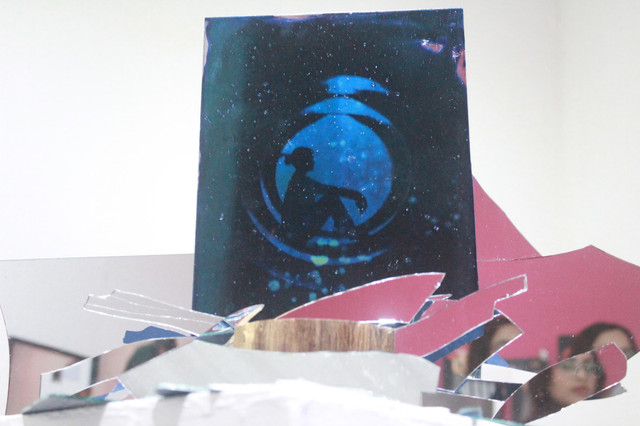Tentang KamiPedoman Media SiberKetentuan & Kebijakan PrivasiPanduan KomunitasPeringkat PenulisCara Menulis di kumparanInformasi Kerja SamaBantuanIklanKarir
2025 © PT Dynamo Media Network
Version 1.102.2
Konten dari Pengguna
Shattered Light : A Photographic Renaissance on Broken Glass
23 Januari 2025 21:08 WIB
·
waktu baca 5 menitTulisan dari Azzahra Putri Purnama tidak mewakili pandangan dari redaksi kumparan

ADVERTISEMENT
Imagine a photograph that isn’t just seen, but felt—through every crack, every reflection of light, and every shard of glass that serves as its canvas. In a captivating art exhibition, photography transcends conventional boundaries by appearing in an unexpected medium: shards of glass. A material typically considered fragile and worthless is now transformed into a captivating vessel of artistic expression, creating a harmony between visual beauty and natural imperfection.
ADVERTISEMENT
Each crack in the glass seems to be an additional storyline, enriching the meaning behind each image. This is not just a photo exhibition, but an emotional experience that invites visitors to view art from a new perspective—where beauty doesn’t always reside in perfection, but rather in the courage to challenge traditional boundaries.
The light that reflects off these shards seems to emphasize the message that beauty can arise from destruction. This innovation not only changes the way we view art but also teaches us that perfection is often hidden behind imperfection. Art is no longer just about what is seen, but what is felt beneath the surface.
Royyan, a visitor at the exhibition, expressed his admiration for the artwork, stating, "The piece beautifully contrasts fragility and strength. The ethereal silhouette of a human figure within a circular frame on shattered glass captivates the viewer. As light filters through the glass, it creates dramatic shadows that enhance its otherworldly quality. The use of glass adds depth, transforming the photograph into a three-dimensional experience that invites exploration." His insights highlight the emotional impact and intricate design of the artwork, making it a standout piece in the exhibition.
ADVERTISEMENT
Rani said the glass printing technique employed in this work is a testament to the artist’s innovation and skill. The meticulous process of creating such a piece requires both technical expertise and a keen eye for detail. The harmonious blend of analog photography and installation art results in a visually stunning and conceptually rich work. By strategically utilizing light as a key element, the artist demonstrates a profound understanding of visual aesthetics, inviting viewers to contemplate the interplay between form, light, and shadow.
Making a cyanotype on glass is no easy feat. It’s a delicate process that involves preparing the glass, coating it with a special solution, and then exposing it to sunlight. The amount of time it takes depends on things like how strong the sun is and how big the piece is. But for artists who love this technique, these challenges are all part of the fun.
ADVERTISEMENT
Salsabila Dwi Tiara Ramadhani (Rani) is one of the exhibitors at the Ephipany Exhibition by FOTKOM 401, a photography organization from UPN. This exhibition will be held at Sangkring Art from December 13 to 15, 2024. "Ephipany" is a major exhibition organized for the classes of 2021, 2022, and 2023 as their annual event. Rani mentioned that she almost did not participate in this exhibition due to the photo printing process using the Cyanotype technique, which requires direct sunlight for drying, while the weather during the exhibition preparation was entering the rainy season. Mirror is one of the mediums that Rani has chosen to express her work and imagination to the public. Using the cyanotype technique, she prints photographs on glass, creating a deep impression for art lovers.
ADVERTISEMENT
However, the process of preparing this work was not easy. “Giving up” is a word that often comes to mind when Rani faces various obstacles, especially the weather. This huge challenge did not stop her from completing the work titled “Sampai Kapan Terus Berjalan”.
The process of printing photos on glass using the cyanotype technique requires high precision. Before printing, the glass is coated with gelatin so that the photo adheres well. This process takes 3-7 days to achieve optimal results. However, the combination of gelatin and cyanotype carries the risk of bubbles or watermarks that could potentially damage the work. Rani revealed that the main challenge this time was to consistently monitor each stage of the printing process to ensure that the blue strokes were perfectly printed on the fragile yet aesthetically pleasing glass medium.
This work represents a unique visual fusion. Although there is no direct connection between the photograph and the glass medium, the glass fragments placed to the right and left of the main work symbolize the obstacles faced. The visualization of a hallway with a seated female silhouette represents a self-awareness that slowly finds the light to emerge from the darkness.
ADVERTISEMENT
Adit, one of the visitors and a member of FOTKA 053 (UMY Communication Photography), expressed his appreciation for this work. “This work presents a combination of fragility and strength. The human silhouette trapped in a circle on the broken glass creates an interesting contrast. The light that penetrates the glass cracks gives a dramatic visual effect, as if this work has a life of its own,” he said.
The process of printing on glass, which combines analog photography and installation art, is an innovation worth appreciating. This technique requires not only precision, but also a deep understanding of visual aesthetics. The three-dimensionality of the glass media presents a more interactive experience, making this work one of the highlights of the exhibition.
ADVERTISEMENT
The “Epiphany” exhibition features 44 artworks, but this glass-based work using the cyanotype technique is one of the most unique. The use of glass as a medium is still rare, even among other members of FOTKOM 401.

